
Galactic Visions by Michael C. Turner. (Reprinted with permission.)
The “Galactic Visions” of Michael C. Turner transports viewers into a fabulously mysterious universe filled with light and color. His canvases are filled with extrasolar worlds, galaxies of stars, brilliantly glowing nebulae, pulsars, quasars, black holes, and other bizarre cosmic phenomena. At first, one might consider these images as fantasy. Turner contends that his creations are, in fact, based upon scientific data and plausibility. He says he paints from his soul with the intent of inspiring the viewer to feel “the spirit of space.” He regards his space art as equally inspirational or sacred art. “The Cosmos reveals the mind and spirit of The Creator,” explains Turner. Ever careful to maintain the balance of inspiring and informing the viewer, he composes detailed descriptors for each of his unique works of space art.
Turner primarily uses acrylic with traditional paint and brush techniques on stretched canvas to express his artistic visions of a living universe unfolding within its cosmic womb. Although he does some digital art, his artistic passion remains faithful in traditionally created canvas paintings. He created many space paintings long before the Hubble Space Telescope commenced imaging areas of space where Earth-based intellects have yet to travel. Prior to the most recent discoveries, Turner’s paintings would have been considered science fiction or fantasy, as there was no physical proof for his insightful images. With each new astronomical discovery, Turner’s conceptual space art is validated by the scientific world. Nevertheless, he contends that his primary objective is to inspire, for all true science is the result of inspired minds. “Consider modern technology,” says Turner, “Mere decades ago, the wonders of audiovisual communication and the universe it has revealed, was an inspired vision. Most people considered it science fiction or fantasy.”
Turner calls his paintings “Space-Scapes.” He says they are vignettes of the Universe, waiting to be discovered. Of the many influential artists in Turner’s life, he says that the visionary space artist Chesley Bonestell is the one who most inspired him to pursue space art. He continues to receive inspiration from many of his fellow IAAA members that he proclaims as contemporary space art visionaries. The prestigious IAAA (International Association of Astronomical Artists) is the only astronomical space artist organization on the planet. This international group of space artists produces the majority of all the astronomical space art on the planet. https://www.iaaa.org
Michael C. Turner’s space art spans more than three decades. His life-long love of space, science, and art are supremely evident in his paintings which have won him honors and awards ever since he received the senior art award in high school. In university Turner pursued multiple fields of science with a focus on space sciences. His myriad interests and skills also lead him to study archaeology (focusing on ancient Egyptian archaeology), anthropology, paleontology, ancient world history, geology, visual arts, and theatrical arts. Fine art was his anchor across this vast academic sea. Turner’s rich background experiences in archaeology and the sciences are frequently incorporated within his paintings. Turner feels that archaeology and space science are natural companions for space-faring civilizations. When viewing the rich, visual detail of Turner’s paintings, one can’t help but ponder whether these are his “visions of space” or “visions he has seen in space.” His paintings invite viewers to take a solitary journey into the depths of a universe that exists equally in their inner-space and outer-space.
Turner’s paintings have been exhibited locally, nationally, and internationally. Many of his works are in private collections. He has exhibited in galleries throughout his career although, he has exhibited more frequently in solitary shows, especially in science facilities and space related art exhibitions He has had resident art exhibits at various planetariums and science facilities. His “Galactic Visions” space art has consistently been exhibited at Elachee Nature Science Center in Gainesville, Georgia for over twenty years and has been part of Elachee’s space science exhibit for nine consecutive years. His work was chosen by the Planetary Society as part of a featured IAAA space art exhibit in Pasadena, California in conjunction with NASA’s July 4, 1997 landing of the Mars Pathfinder expedition. Turner’s“Galactic Visions” were exhibited at the 1996 Olympics in Atlanta, Georgia and in projected digital imagery in Sydney, Australia during the 2000 Olympics celebrations. His art has been published in space art books. Most recently, Turner’s space art was published (along with a host of fellow IAAA space artists) in the 2011 International Association of Astronomical Artists’ space art book entitled “The Beauty of Space.” Turner’s paintings are based upon scientific data, however, his paintings have also been published in science fiction related books, appearing most recently in Craig Musselman’s 2011 “Machines and Magic.”
Although space art is a vital part of his life, Turner has pursued many other interests over the years along with his multi-talented soul mate and wife, Linda Turner. He was a professional educator for twenty five years. He has actively engaged in a wide array of archaeological excavations and continues in archaeological pursuits when not creating his “Galactic Visions.” His many fields of study and interests are augmented by his professional photography and writing skills. In addition to contributing to professional journals and conducting seminars, Turner is also an accomplished published writer. He especially enjoys composing meditative prose and verse. One of his meditative poems entitled “Star Hymns” was published in “Silence of Yesterday,” an anthology of poems of the twentieth century’s best poets. “Star Hymns” was dedicated in memory of the late Carl Sagan, the acclaimed astronomer of the PBS Cosmos series. Turner’s painting, “Star Hymns” and his poem of the same title are excellent examples of how he integrates the two art forms.
Star Hymns
Copyright 1994 by Michael C. Turner
Silently, deep in space your sacred hymns call to me;
Ancient hymns sung before the dawn of sentient souls.
Spiritual, mystical, enlightening messages of divine creation.
Soothing notes of sublime beauty and power,
Echoing through time and space until, at last,
They resound from my inner being.
Holy of Holies, Star Hymns, I know we are kindred spirits,
Separated by time and space; light years away, yet ever close.
Aliens and yet, strangely, we mirror each other’s souls.
Sing your eternal hymns silent singers!
Let the myriad galaxies of stars join in the chorus,
Sing ye heavens, lift up your souls children of dust…
Turner began an annual limited edition space art Christmas card series in 1991, entitled “Christmas in the Stars.” He integrates his space art, detailed descriptors, and meditative sacred verses to create unique space-themed Christmas cards. He shares the physical cards with his closest friends and relatives and posts them on various internet sites for everyone to freely enjoy.
In recent years, Turner has focused more on creating his “Galactic Visions” rather than expending excessive time with exhibitions. He most frequently creates private commissions which he says are far more enjoyable than seeking public venues. Although there are other talented space artists, the Galactic Visions of Michael C. Turner are truly unique in any world. If viewing art is the first level of art appreciation, and if feeling the spirit of the art and the artist is the ultimate level, then Michael C. Turner’s space art is the portal for that continuum. Turner says, “When I express myself through my art, my spirit soars, filling my canvasses with “Galactic Visions” from cosmic realms where no one has gone before . . .”

(Acrylic on stretched canvas 36 x 48”) * 2010 Christmas in the Stars Card Cover*
Shinning brilliantly from the womb of a birthing nebula, a new-born quasar “star” illuminates the central regions of a newly forming spiral galactic mass or proto-galaxy. Galactic arms spiral outward, thousands of light years or trillions of miles, revealing myriad clusters of star-filled nebulae with swirling orbs of stellar gases and dust which will ultimately give birth to new generations of stellar families. An Earth-like planet is bathed in the virgin light of the cosmic lighthouse, otherwise known as a quasar, as it transits creating intriguing imagery of a celestial, Christmas Star, vignette. Two other companion worlds (one in the extreme upper right and the other near the extreme left middle) are approaching similar stellar conjunctions making this a tri-stellar/planetary conjunction. Such scenes as this, once considered only hypothetical, are now supported by astronomical science. In recent years extra-solar worlds (planets orbiting other stars/suns outside Earth’s solar system) have been discovered using orbiting space telescopes such as the Hubble Space Telescope as well as ground-based radio telescopes. These extra-solar worlds or exoplanets orbit distant stars/suns, some similar to Earth’s sun, while others orbit giant and super giant stars immensely larger than Earth’s closest star, the Sun. Considering the aforementioned, one would reason that life must assuredly exist on at least some of these remote worlds
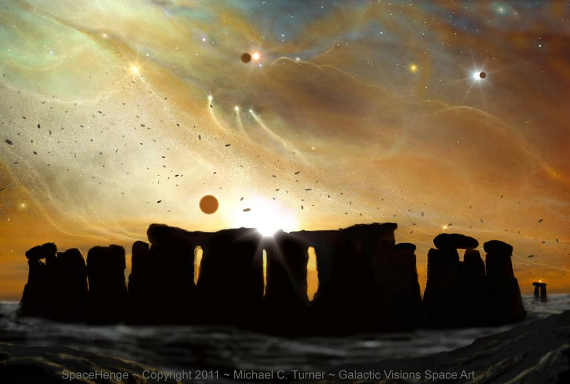
(Acrylic on stretched canvas 70 X 90”) Private Collection
A space “solstice” within a genesis nebula as viewed from the surface of a hypothetical planet with a Stonehenge-like configuration. (One of Turner’s astroarchaeological / archaeoastronomical paintings.)
*Featured in the International Association of Astronomical Artists’ 2011 book “The Beauty of Space* *Featured in Craig Musselman’s 2011 book “Machines and Magic”
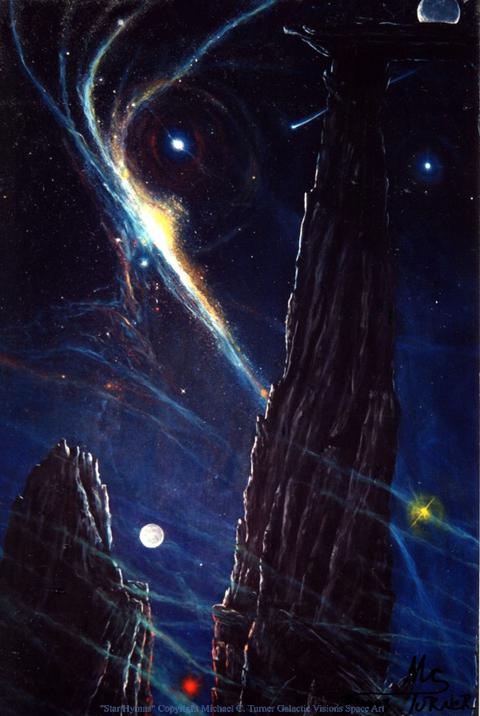
(Acrylic on stretched canvas 36 x 60”) * Private Collection*
A cosmic alignment as viewed though ancient megalithic portals on a planet in a multiple star system. The remains of a companion spiral galaxy (now an irregular galaxy) viewed on its galactic plane dominates the night sky. The companion galaxies “collided” eons ago, ripping star systems from their native galaxies, scattering them across intergalactic space, to become either nomadic star systems or gathered into the gravitational womb of the companion galaxy. Such events happen more frequently than was once theorized by cosmologists. In fact, the Milky Way Galaxy and its nearest companion galaxy, The Andromeda Galaxy, will likely have a similar close encounter in the distant future . . .
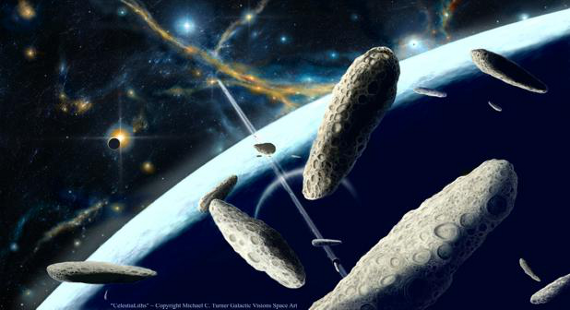
(Acrylic on stretched canvas 48 x 60”) Private Commission
The Cosmos is so immense that one could just as well consider it as infinite. The known “universe” is assuredly only a minute speck relative to the true size and nature of the actual Cosmos. Earth based intellects have examined and explored only a microscopic portion of the Cosmos and now realize that even the closest stellar systems within the home galaxy harbor extrasolar worlds, some which are assuredly Earth-like. “Super-Earths” several times the size of Earth are known to exist. Such colossal terrestrial planets would assuredly be magnificent. Exotic stellar systems with such super-worlds stimulate the mind and fuel the imagination. Imagine the vistas within such a system. Advanced extra-solar civilizations would likely create new worlds by terraforming on a grand scale, perhaps even creating new companion worlds with rings composed of modified asteroids or planetoids.
In this painting Turner has visualized the aforementioned scenario. The primary planet depicted is a “SuperEarth” within a multiple stellar system which emerged from the womb of an exotic cluster of novae. An artificially engineered ringed planetoid has been created and closely orbits the primary planet. The colossal asteroids in the foreground have been modified to function as natural spaceships and conceal the advanced miniature worlds within. These CelestiaLiths, appearing natural, are actually the artifacts of an extremely advanced civilization. They travel within and beyond the stellar system and can function independently or collectively as in the myriad ones composing the engineered ringed planetoid. Imagine what knowledge such an advanced extrasolar civilization would possess to enable them to engineer such fantastical artifacts which masquerade as natural artifacts of the Cosmos . . .

(Acrylic on stretched canvas 30 x 40”)
(Dedicated in honor of Chesley Bonestell . . . The grandfather of Space Art)
A ringed extra solar planet (exoplanet) as viewed from the icy surface of its companion in a remote galaxy. This scene is reminiscent of some of the early space art of Chesley Bonestell who was a pioneer of astronomical and space art in the 20th century. His art influenced many space artists with stunning depictions of space decades before the space program. This painting is dedicated in honor of and gratitude to Chesley Bonestell for the positive influence he had, and continues to have, on inquiring minds seeking the wonderment of the Cosmos and all its myriad mysteries . . .
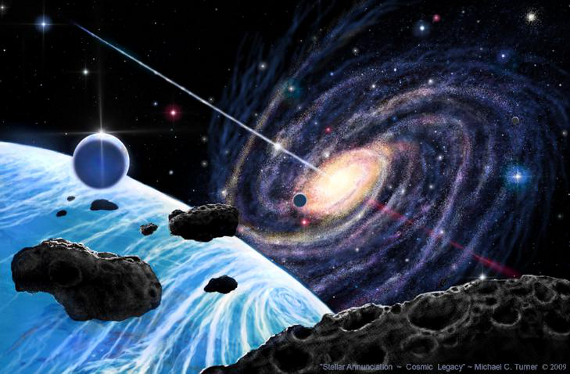
Acrylic on stretched canvas 36 x 48” (Private Collection)
A brilliant burst of light announces the birth of a cosmic phenomenon deep within the womb of a spiral quasar galaxy, creating bi-polar beams, illuminating the shores of space like a celestial light house. A colossal Earth-like planet and its lunar siblings (in a stellar system within a companion satellite galaxy) are bathed in celestial light. Sentient life-forms on planets in both galaxies would assuredly associate such cosmic events with myth, lore, legend and prophecy. Ancient civilizations on planet Earth frequently attributed celestial phenomena with positive and negative interpretations of social, political and religious events. One particularly unique celestial event, The Star of Bethlehem, announced the birth of the prophesied Messiah, Jesus Christ. Magi or Wise Men (ancient scholars-priests-astrologers-astronomers) from “the east” associated the Old Testament Messianic prophecy, that a “Star” would come out of the tribe of Judah (Numbers 24:17), with this uniquely significant celestial phenomenon, the now Legendary Star of Bethlehem, and followed it to present royal gifts of gold, frankincense, and myrrh in adoration and worship of The New Born King of Kings, Jesus Christ. The Bible Gospels relate the birth, life, sacrificial death and the Victorious Resurrection of Jesus Christ who Saved, not only His People (The Jews) from their sins, but equally Saved His World and His entire Universe! With such a “Stellar Annunciation,” Jesus Christ is truly God’s “Cosmic Legacy.”
*The Annunciation was the Archangel Gabriel’s visit to the Virgin Mary to announce that she had been chosen to be the mother of Jesus Christ. (Luke 1:26-38)
*Numbers 24:17: I shall see him, but not now: I shall behold him, but not nigh: there shall come a Star out of Jacob (Judah) and a Sceptre shall rise out of Israel, and shall smite the corners of Moab, and destroy all the children of Sheth . . .
Michael C. Turner * Christmas * Anno Domini * 2009

©2012 Michael C. Turner ~ Galactic Visions Space Art Acrylic on stretched canvas 36 x 48″
*Christmas in the Stars 2012 Christmas card cover (above) with back descriptor (below)*
A rare alignment of stars and their host of celestial bodies create an inspirational iconic vista in a multiple star system located in one of the outer arms of a remote spiral galaxy. Three of the companion stars/suns align with the fourth primary star/sun creating a dual triangular visual configuration as the primary star appears to provide unity of the three companion stars as well as manifest its intensity to the terrestrial class planet in the foreground.
The Cosmos is filled with wonders beyond imagination. Since ancient times the night sky has inspired innumerable minds to ponder the mysteries of the Cosmos. Inevitably, sentient beings must leave the terrestrial home cradle to explore distant celestial frontiers. Celestial events were often regarded as heralds of divine interaction with the mortal world. Every ancient civilization created myths and legends to relate such cosmic events to human history through the spoken and/or written word. The ancient Hebrew people were closely linked with nature and their religious literature is filled with accounts of God speaking to humans through iconic natural terrestrial and celestial events. The most notable celestial event, The Star of Bethlehem (The Christmas Star), herald the birth of the promised Messiah, Jesus Christ. Ancient learned astrologers or astronomers called Magi or Wise men charted and followed this celestial messenger to Bethlehem so that they might worship this divine star, the child of prophecy, the newborn King of the Jews, Jesus Christ. The birth of Jesus Christ was unique if for no other reason than in no other accounts of any civilization has a divine birth commanded such global attention throughout the millennia. More significantly, it chronicles God, the Creator Father, transcending the spiritual world to become mortal flesh in Christ, The Son, in the physical world. This was indeed the Divine Cosmic Trinity of God The Father, Christ The Son and the manifestation of The Holy Spirit.
. . . And The Word Was Made Flesh And Dwelt Among Us . . . (KJV)
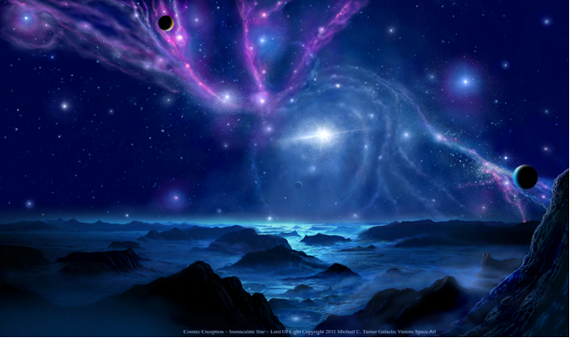
©2011 Michael C. Turner ~ Galactic Visions Space Art
(Acrylic on stretched canvas 60 x 72”)
From deep within the fertile womb of a star-rich nebula, a brilliant new-born star, a nova, illuminates the shores of an extrasolar planet in a remote galactic realm. This “Lord of Light” makes all other stars dim in comparison as its intensive light beams become exponentially brighter. Dispelling the nebular dust clouds, which previously shrouded it from direct observation, it diminishes the light of its stellar siblings. Viewed from the misty surface of a super-size terrestrial exoplanet, its cosmic beacon bathes the night sky and the planet’s surface like a celestial lighthouse with an ethereal light, revealing a world with abundant liquid water, one of the prerequisites for life. Three of the primary planet’s satellite companions traverse the nebular background creating a dramatic otherworldly scene that may be far more common than rare according to modern cosmological data. Sentient beings, across space and time, witnessing such a Cosmic Conception would assuredly proclaim this Lord of Light an Immaculate Star.
“He Determines The Number Of Stars And Calls Them Each By Name.” Psalm 147:4 (NIV )Michael C. Turner * Christmas * Anno Domini * 2011
Cosmic Conception ~ Immaculate Star ~ Lord Of Light is number 21 in “Christmas In The Stars” limited edition series by Michael C. Turner * ©2011

© 2009 – 2013 ~ Michael C. Turner ~ Galactic Visions Space Art (Digital Painting)
A pulsar, neutron star, shines brightly as it spins rapidly; emitting a beacon of light which illuminates the rocky shores within a liquid-filled crater of an extrasolar planet. Pulsars are the “stellar lighthouses” of the Cosmos and some have been discovered in multiple star systems with extrasolar planets.

©2010 – 2013 ~ Michael C. Turner ~ Galactic Visions Space Art
Acrylic on stretched canvas 36 x 48”
The north circumpolar constellation commonly known as Draco is the domain of numerous binary and several multiple star systems. One optical star in Draco’s head, Nu Draconis, is actually a double or binary star which astronomers refer to as Nu1 and Nu 2. Both are dwarf white class stars which are about 70% larger and 9 times more luminous than Sol. They are slightly hotter than Sol (6,000K) at about 8,000K each. Nu 2 has another close companion of lesser stellar mass (Nu 1 may also have a smaller stellar companion). These two white dwarf stars are depicted as viewed from a possible exoplanet orbiting Nu 2’s lesser stellar companion. Jets of volcanic plumes consisting of gas, steam, and pyroclastic debris erupt from ancient calderas as a result of massive subterranean volcanism created, in part, by the complex gravitational influx fields within this multiple stellar system.

©1995- 2013 Michael C. Turner ~ Galactic Visions Space Art
Acrylic on stretched canvas/ traditional bristle brush 48 x 60″
Transiting eons of time sculpted rock arches stand before an ancient sky serving as geological and meteorological monuments of a remote extrasolar planet’s past and shall continue their time travel until, eventually, they too shall become the sands of time . . .
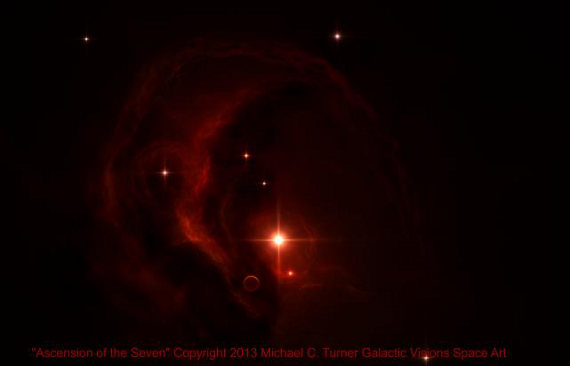
©2009 – 2013 Michael C. Turner Galactic Visions Space Art
Digital Painting
Seven new stars ascend from their stellar womb in a genesis nebula.

© 2010 – 2013 ~ Michael C. Turner ~ Galactic Visions Space Art
Acrylic on stretched canvas 30 x 40″

©1984-2013 Michael C. Turner Galactic Visions Space Art
*Created by modifying a photograph of an original acrylic painting using Corel Photo-Paint 12.
A massive, ringed, extrasolar planet in a distant galaxy is viewed from the surface of one of its multiple moons orbiting the ring axis. A mysterious atmosphere is created as a blue mist enshrouds silhouetted rock towers in the background and flows down the walls of a huge ancient volcanic caldera in the foreground. Further intrigue is created by the impact of comets with the ringed planet. The irregular rock/ice ring is the result of previous such collisions.
The original painting was created over a quarter century ago in acrylic on a 36×36” stretched canvas using bristle brushes. I was relatively happy with the painting then however, I decided to revisit this scene and make some digital modifications. Even though I still create most of my art using traditional materials and techniques, I find that digital enables me to go back to former works and try some of those “what if” ideas that I would never do to the original. The result is a gallery of digital variations on the original themes. Sometimes the modifications are very minute while more extensive modifications transform the original into an entirely different image. This frequently provides new inspiration to create similar works of art using traditional materials and methods. More recently I have been creating digital images from scratch. With these added to my image gallery, I have copious archives to energize me when I get those occasional feelings of not knowing what I want to paint. Modifying previous works of art digitally is one way to breathe new life into some old ideas without having to “recreate” the entire Universe . . .
Michael C. Turner’s Galactic Visions’ space art can be viewed at:
Galactic Visions Space Art
The International Space Art Network and Here
DeviantArt
Michael C. Turner’s On Facebook










